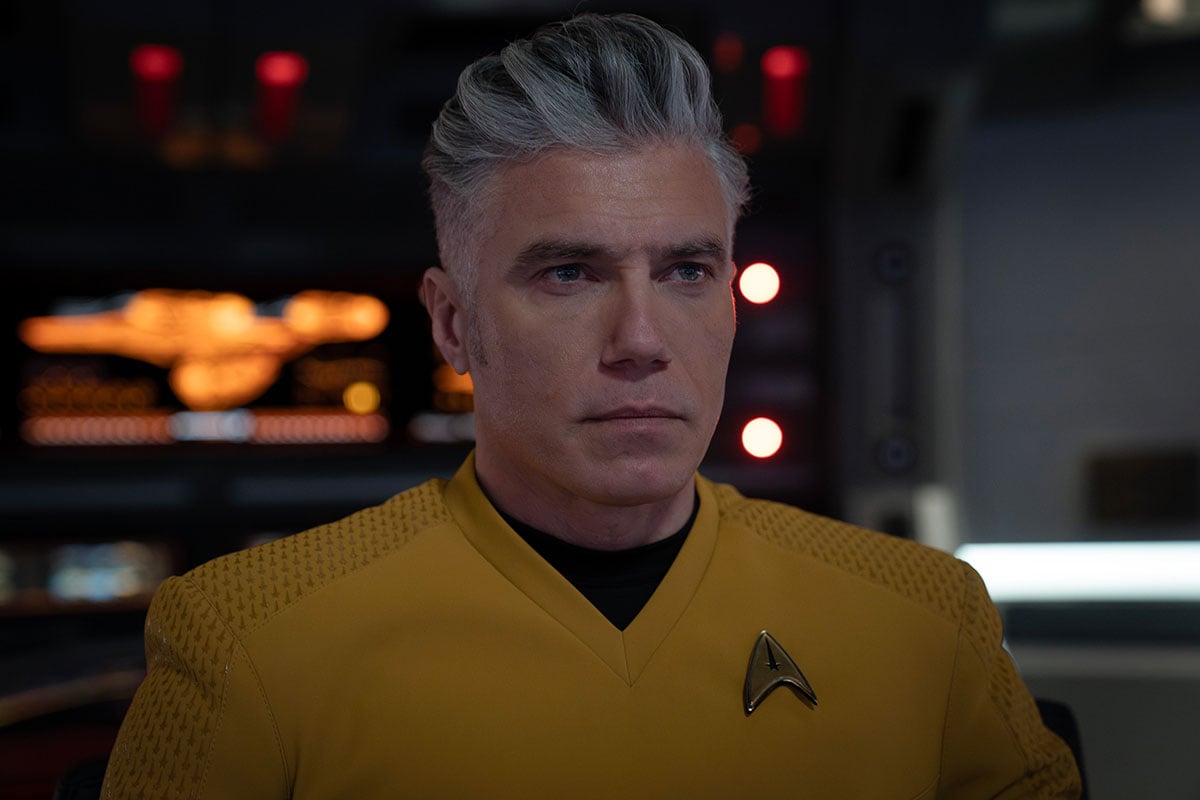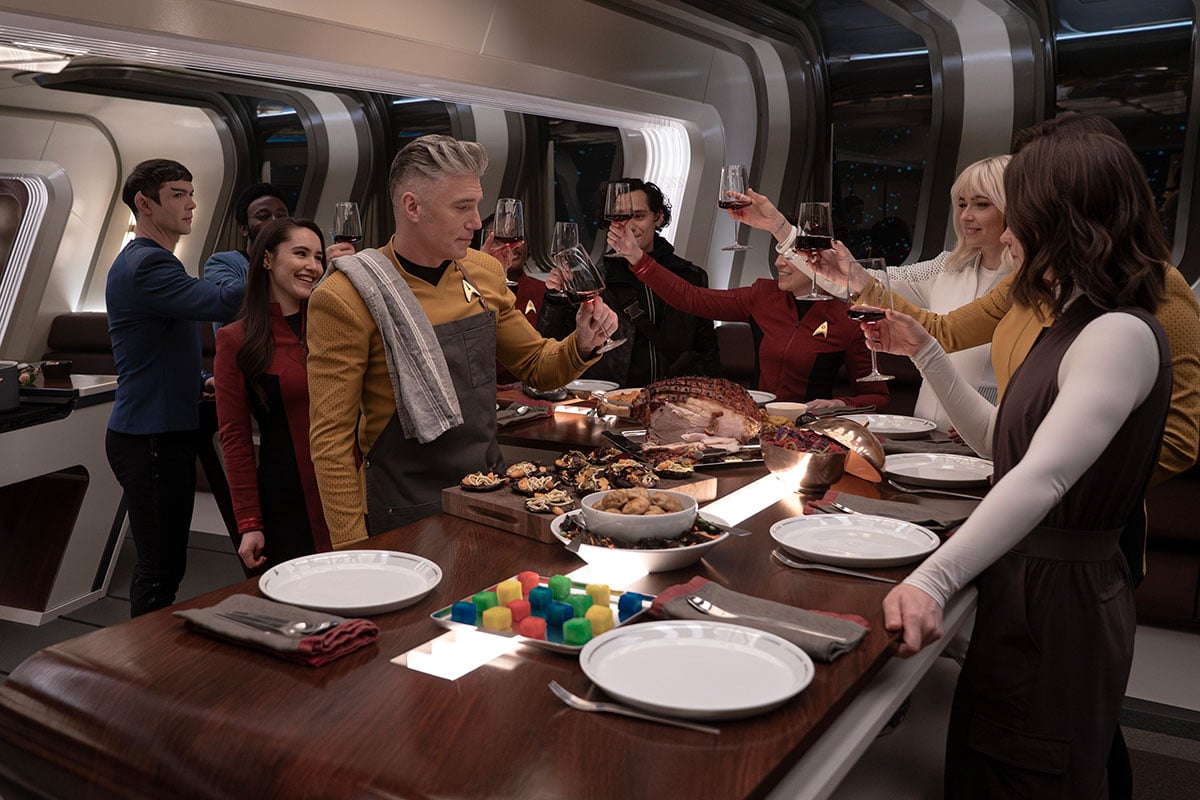Star Trek: Strange New Worlds is, at this point, very clearly a series that is unafraid to dabble in its format on a regular basis. That can lead to episodes of Star Trek that don’t necessarily look or feel like what we expect of Star Trek, even if they still play with ideas and approaches that fit into what the franchise has done for generations now. This week’s Strange New Worlds definitely fits into both of those ideas, with an episode in a new format, an in-universe documentary, and an episode that tries to raise one of the oldest critiques of the franchise with one question: is Starfleet an organization of scientific inquiry or a martial tool of empire?
Unfortunately, this means this is an episode that wants to be two things at once… and ultimately spectacularly fails at being either.
“What Is Starfleet?” tells two stories at once. One is the Enterprise‘s mission to the Lutani—a non-Federation civilization which has requested aid in a conflict with their sister world, Kasar, through the transportation of a large spacefaring creature called a Jikaru, a giant part-whale, part-moth kind of psionically powerful sentient being for purposes unknown. It quickly becomes clear to the Enterprise crew that, despite their strict orders from Starfleet command, they have concerns about the Lutani’s treatment of the Jikaru and their intent for the creature in a war that they are in the process of losing badly. Although the story never explicitly details just how impactful the casualty figures of the Lutani/Kasar conflict are to their respective peoples, we are told that nine million Lutani had perished, to “just” 119,000 Kasar in comparison.

There is an interesting set of morals at play here that Strange New Worlds allows its vast swath of characters to come at from different angles, giving “What Is Starfleet?” a ton of potential. Ortegas is distrusting of working with the Lutani because the species purportedly supported the Klingons and raided Starfleet shipments during the Empire’s war with the Federation. Pike and Una bristle that Starfleet is giving them orders to follow without a fuller picture of the situation at hand. Spock and Uhura dislike having to follow these orders and instead hatch an alternate plan to find ways to communicate with the Jikaru itself. All this becomes an increasing dilemma when the Enterprise crew slowly discovers that the Jikaru is immensely powerful, that at least some Lutani object to their government’s plan for the creature, and eventually discovers that the Lutani have genetically engineered and mentally altered the Jikaru into essentially a sentient living weapon of mass destruction, one that realizes that it has been altered to think of only violence and death, while fearing that the same may happen to its children.
Eventually, as tension mounts and the Jikaru’s massive psionic outbursts threaten to potentially destroy the Enterprise before the crew can even morally reckon with the fact that a living creature-weapon has begged them to euthanize it, the Enterprise decides circumstances have evolved enough that Starfleet command’s initial orders can be challenged. Pike threatens the Lutani military with a very powerful enemy in the Federation if they do not allow Enterprise to escort the Jikaru to a nearby sun to immolate itself, and Starfleet moves to put the Jikaru’s home world under ecological protection to ensure that the Lutani cannot modify its children into similar results, seemingly inevitably leaving the Lutani to defeat and potentially genocide in their conflict with the Kasar.
All that sounds pretty good, and for the most part, it kind of is—getting to see individual elements of the Enterprise bridge crew wrestle with orders no one necessarily agrees with, for various different reasons, leads to some fascinating tension and friction. It touches on broader themes the episode wants to play around with that Star Trek itself has pondered in fits and starts for decades: questioning Starfleet’s role as a simultaneous exploratory scientific organization and a military force that can be tasked with either defending the Federation’s borders or intervening in non-Federation conflicts with impunity. What happens when those two halves of Starfleet have to be reconciled? Can they ever truly be?

Unfortunately, what I’ve just described is not the actual episode of Strange New Worlds that aired this week. The actual episode that aired is an incredibly poor documentary made by Ortegas’ brother, Beto (returning guest star Mynor Lüken), also called “What Is Starfleet?”, that has so little idea of what it’s ultimately trying to do that he should’ve looked at the footage in whatever the 23rd-century equivalent of an edit bay is, and decided to never let a member of the public see the shitshow he’s made.
“What Is Starfleet?”, both the Strange New Worlds episode and Beto’s creation as a filmmaker/journalist, is entirely in that documentary style, presented metatextually as if we are watching his work rather than an episode of Star Trek. Everything noted above about the Lutani mission is interwoven throughout camera footage from various sections and stations aboard Enterprise, or via Beto’s hoverdrone cameras. Either drone technology has not improved in a society where faster-than-light travel and near-instantaneous matter transportation exist, or Beto is deliberately going for a shaky-cam aesthetic to lend his documentary an air of cinéma-vérité, but regardless, he is an awful videographer, repeatedly shoving cameras way too close in people’s faces or capturing things at obtuse and overtly dramatic angles that make for an incredibly frustrating viewing experience.
Beto is also likewise an awful interviewer. Intercut through all the above are 1:1 interviews Beto conducts from behind camera with various members of the crew. Some are better than others, and occasionally make an interesting use of the editing format to convey the message Beto wants to convey (for better or worse, as we’ll get into). He contrasts interviews where Pike acknowledges the duty of Starfleet to uphold the values of the Federation, with candid footage of him bristling at command’s orders, or interviews with La’an where she discusses the necessity of security and the last-line option of being forced to engage in lethal conflict with footage of her in a slick, leather training uniform performing phaser-kata in a training drill. But overall Beto’s documentary suffers because he has put too much of himself into it for it to be considered as a challenging piece of investigative journalism into, as his opening narration frames it, whether or not the Federation is a diplomatic entity engaged in peaceful exploration of the galaxy or a colonizing empire with Enterprise as its flagship weapon of war.

But broadly the majority of the other interviews Beto conducts for “What Is Starfleet?” are at best probing to the point of a clear attempt to construct a pre-established argument—about 80% of his documentary, as haphazardly shot and constructed as it is, is clearly intended as an exposé of Starfleet as a nefarious, untrustworthy entity, masquerading warmongering militarism with a veneer of frontier diplomacy—and at worst deeply, personally invasive to his subjects. We cut from footage of Doctor M’Benga and Nurse Chapel failing to save the life of a Lutani scientist mortally wounded by the Jikaru after attempting to stop Enterprise from escorting it from its homeworld straight to an interview between Beto and M’Benga, where the former probes the latter about his military service in the Klingon-Federation war. Similarly, in his interview with Uhura—for who Beto has been introduced this season as a potential romantic interest—he cruelly surprises her with the revelation that one of the only friends she made at Starfleet Academy was killed in action aboard the U.S.S. Cayuga during the events of last season’s finale in an attempt to provoke a shock reaction, taking advantage of their closeness in the process.
Again and again throughout the bulk of “What Is Starfleet?” Beto establishes a very clear bias in his framing, with little in the way of real tangible evidence outside of the combative tone of leading questions, or the irritance he attempts to provoke by shoving his drones in everyone’s faces. It undercuts the valid question at the core of his argument about Starfleet’s conflicting duties and ideals for the audience, fictional or otherwise, because the documentary becomes less and less about that question, and more and more about why it seems that Beto wants to ask a question he apparently knows the answer to in the first place. Even though he is largely off camera throughout, “What Is Starfleet?” as a documentary makes its documentarian the subject—and although that is a perfectly reasonable approach for the medium in many ways, it almost certainly isn’t for a documentary made off of the back of what is believed by that documentarian to be investigative reporting aboard a perceived military warship.
It’s not helped then that around 80% of the way in, “What Is Starfleet?”—both the documentary and the episode—turns its vision on a dime. After Uhura communicates with the Jikaru and learns of its desire to be euthanized and the extent to which the Lutani have bioengineered it into a weapon, we see a stark sit-down between herself and Beto from an off-angle where she plainly tells him that he came into making this documentary angry and with a point to prove out of spite: he was mad that his sister joined Starfleet and left him behind, and he was mad that she got hurt in service of the organization that took her from him. Being told off, in combination with the Enterprise‘s decision to go against its initial orders and aid the Jikaru in killing itself, turns the final act of the documentary and episode into a noble celebration of Starfleet’s ideals. Actually everything’s fine, and Starfleet is very good, and at the end of the day, as chintzy interview narration from Uhura tells us as the documentary closes over shots of the Enterprise bridge crew sharing dinner in Pike’s quarters, the answer to “What Is Starfleet?” is the people that serve in it.

And with that, “What Is Starfleet?” fails to be both an effective documentary and an effective episode of Star Trek. Even putting aside that Beto’s anti-Starfleet bias came out of nowhere in this episode, despite his prior appearances, the result of the last-minute tonal change renders both the documentary and the episode’s potential critiques of Starfleet as an organization impotent. The documentary framing means the episode’s narrative around the Lutani mission is not given the chance to decompress and consider the emotional impact on any of our characters; they just get to be shown having a nice time and having dinner together. Given its metatextual existence as a documentary, Beto’s clarity of vision as a filmmaker is muddied into flip-flopping from one extreme to another, from hit piece to puff piece, because he got told off by a girl that he likes. If this were a real documentary, Beto changing his mind should’ve led to it being reconstructed in the edit process entirely—even to make the fact that he came into this process with a preconceived notion that was ultimately challenged and proved incorrect the narrative arc of the piece, if not just to avoid the final product looking like two fragments of two radically different documentaries.
“What Is Starfleet?”, both as an episode and as a documentary within the universe of Star Trek, ultimately has no idea what it actually wants to say about the question that Star Trek has tried to wrangle with for over half a century at this point. And if that was going to be the case, then maybe Beto should’ve killed his story before it ever got on air.
Want more io9 news? Check out when to expect the latest Marvel, Star Wars, and Star Trek releases, what’s next for the DC Universe on film and TV, and everything you need to know about the future of Doctor Who.
Read the full article here












